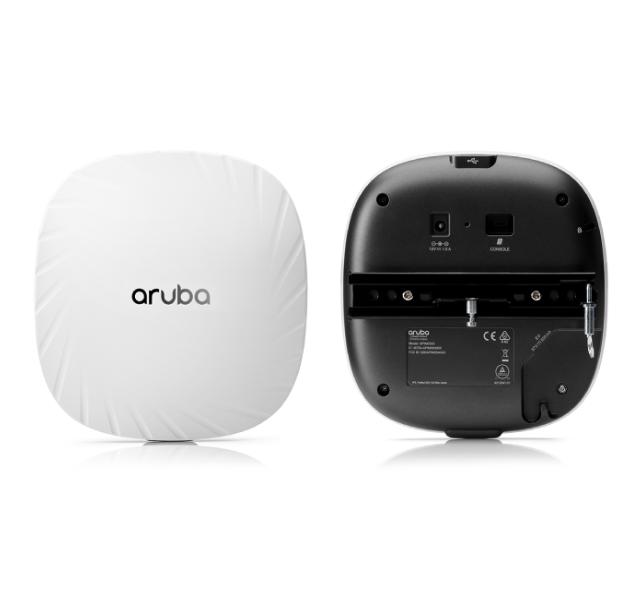| AP type: Indoor, tri-radio, 2.4GHz, 5GHz and 6GHz (concurrent) 802.11ax 4×4 MIMO
2.4GHz radio: Four spatial streams MIMO for up to 1,147Mbps wireless data rate with HE40 802.11ax client devices
5GHz radio: Four spatial streams MIMO for up to 2.4Gbps wireless data rate with HE80 802.11ax client devices
6GHz radio: Four spatial streams MIMO for up to 4.8Gbps wireless data rate with HE160 802.11ax client devices
Both downlink and uplink MU-MIMO in 6GHz and 5GHz, downlink only in 2.4GHz
Up to 512 associated client devices per radio, and up to 16 BSSIDs per radio (limited to 4 for the 6GHz radio)
Supported frequency bands (country-specific restrictions apply):
-
- 2.400 to 2.4835GHz ISM
- 5.150 to 5.250GHz U-NII-1
- 5.250 to 5.350GHz U-NII-2A
- 5.470 to 5.725GHz U-NII-2C
- 5.725 to 5.850GHz U-NII-3/ISM
- 5.850 to 5.895GHz U-NII-4
- 5.925 to 6.425GHz U-NII-5
- 6.425 to 6.525GHz U-NII-6
- 6.525 to 6.875GHz U-NII-7
- 6.875 to 7.125GHz U-NII-8
Available bands and channels: Dependent on configured regulatory domain (country)
Dynamic frequency selection (DFS) optimizes the use of available RF spectrum in the 5GHz band
Supported radio technologies:
-
-
- 802.11b: Direct-sequence spread-spectrum (DSSS)
- 802.11a/g/n/ac: Orthogonal frequency-division multiplexing (OFDM)
- 802.11ax: Orthogonal frequency-division multiple access (OFDMA) with up to 37 resource units (for an 80MHz channel)
Supported modulation types:
-
- 802.11b: BPSK, QPSK, CCK
- 802.11a/g/n: BPSK, QPSK, 16-QAM, 64-QAM and 256-QAM (proprietary extension)
- 802.11ac: BPSK, QPSK, 16-QAM, 64-QAM, 256-QAM and 1024-QAM (proprietary extension)
- 802.11ax: BPSK, QPSK, 16-QAM, 64-QAM, 256-QAM and 1024-QAM
802.11n high-throughput (HT) support: HT20/40
802.11ac very high throughput (VHT) support: VHT20/40/80/160(80+80)
802.11ax high efficiency (HE) support: HE20/40/80/160
Supported data rates (Mbps):
-
- 802.11b: 1, 2, 5.5, 11
- 802.11a/g: 6, 9, 12, 18, 24, 36, 48, 54
- 802.11n: 6.5 to 600 (MCS0 to MCS31, HT20 to HT40), 800 with 256-QAM (proprietary extension)
- 802.11ac: 6.5 to 1,733 (MCS0 to MCS9, NSS = 1 to 4, VHT20 to VHT160(80+80));VHT80); 2,167 with 1024-QAM (MCS10 and MCS11, proprietary extension)
- 802.11ax (2.4GHz): 3.6 to 1,147 (MCS0 to MCS11, NSS = 1 to 4, HE20 to HE40)
- 802.11ax (5GHz): 3.6 to 2,402 (MCS0 to MCS11, NSS = 1 to 4, HE20 to HE160(80+80))HE80)
- 802.11ax (6GHz): 3.6 to 4,804 (MCS0 to MCS11, NSS = 1 to 4,HE20 to HE160)
802.11n/ac packet aggregation: A-MPDU, A-MSDU
Transmit power: Configurable in increments of 0.5 dBm
Maximum (aggregate, conducted total) transmit power (limited by local regulatory requirements):
-
- Per radio/band (2.4GHz / 5GHz / 6GHz): +24 dBm (18dBm per chain)
- Note: conducted transmit power levels exclude antenna gain. For total (EIRP) transmit power, add antenna gain.
Advanced Cellular Coexistence (ACC) minimizes the impact of interference from cellular networks
Ultra Tri-Band (UTB) enables ultimate flexibility in 5GHz and 6GHz channel selection without performance degradation
Maximum ratio combining (MRC) for improved receiver performance
Cyclic delay/shift diversity (CDD/CSD) for improved downlink RF performance
Space-time block coding (STBC) for increased range and improved reception
Low-density parity check (LDPC) for high-efficiency error correction and increased throughput
Transmit beam-forming (TxBF) for increased signal reliability and range
802.11ax Target Wait Time (TWT) to support low-power client devices |




